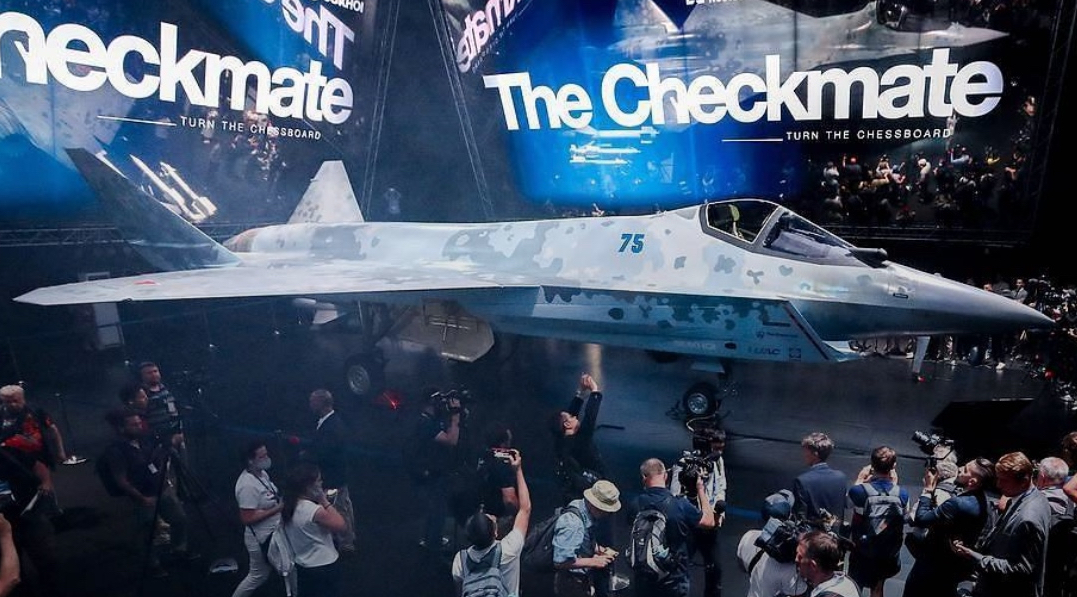After Turkey, will the US deprive another key ally of powerful F-35 stealth fighter jets over growing ties with Russia? Earlier, Washington had expelled Ankara from its F-35 Joint Strike Fighter program for its decision to acquire S-400 missiles from Moscow.
US Delivers Its Most Powerful Air Dominance Fighter Jet To Qatar; Looks To Seal Multi-Billion Indian Deal Next
Russia’s Su-75 has garnered a lot of international attention – its unorthodox design by Russian standards, small size, an excellent composition of avionics and payload, which is more than comparable to other existing aircraft of its class.
Borrowing heavily from American F-35 and X-32, it is the first single-engine jet fighter the Russians have produced after the swing-wing MiG-23.
The plane called CheckMate’ was revealed on July 22 at the MAKS 2021 air show, with a pre-launch promotional video showing a UAE, Vietnamese and Indian pilot rushing to a hangar to see the new aircraft after each one of them receives alerts on their mobile phones.
This indicated the fighter jet was designed with a leading commercial-industrial purpose of marketing it to these countries.
And being a Russian product, the platform could be in a joint production partnership with foreign defense manufacturers. Whether it is full Transfer of Technology (ToT), license production, or assembly with Knockdown Kits (KK) is left to the outcome of the negotiations between the country concerned and Russia.
Indian Fighter Jets To Be Equipped With Same Missiles As F-35 Lightning II, Eurofighter Typhoon
Is UAE A Potential Buyer Of Su-75?
Hints of the UAE buying the Su-75 were visible in 2017 when the Emiratis evinced interest in the plane during the 2017 Dubai Air Show, following development cost-sharing agreement between the two nations then.
Russia is said to have gone for a pre-development agreement after its experience with India, where the latter opted out of the Su-57 program.
Moscow was first courting New Delhi for joint development and later at least joint under-license production, but the latter judged the plane to having design issues and poor stealth, which led it to eventually exiting the project.
‘Hanging In Air’: Why US-India Deal On ‘Super Lethal’ MQ-9B SeaGuardian Drone Is Yet To Take Off
However, the UAE is expected to attract US sanctions under its Countering America’s Adversaries Through Sanctions Act (CAATSA), which Turkey has been slapped with, and India could be next in line.
The latter two are customers of the Russian S-400 surface-to-air missile (SAM) system, where Turkey was sanctioned in December 2020 after three years of a tussle between Ankara and Washington.

While the US disapproves of its allies buying a Russian system through CAATSA, another reason is the S-400 posing a threat to the F-35 jets, whose stealth characteristics are said to be compromised by the SAM’s capabilities.
Interestingly, Turkey was also a financial and manufacturing partner country in the F-35 program itself, a status it lost in August 2019.
By February this year, Turkey offered to not operationalize the first batch of the S-400 system in return for US sanctions relief. Even India could face US sanctions if it goes ahead with its own S-400 purchase.
UAE’s F-35 Deal
The UAE also struck a $23 billion arms deal with the US under the Trump administration, as part of which it is slated to receive 50 aircraft from 2025 onwards. This now raises a Turkey-like situation where if the UAE goes ahead with Su-75 CheckMate, it would certainly invite US sanctions.
Even more ironically, the Su-75 was designed precisely as a commercial competitor to the F-35 itself, which costs less than half at $25-30 million, as against the $80 million per unit price of the latter.
Moreover, with the Russian penchant for simplicity, the Su-75 is expected to be without the litany of technical issues that bogs the F-35, which led the US Air Force to officially admit the plane was a “failure” and that it could do without it.

So far, the UAE has not officially gleaned interest in buying either the Su-75 or even the Russian Pantsir hybrid gun-missile anti-aircraft system. But it is certain to invite action from the US if it announces any such procurement.
While sanctions for such a key US ally, which has firmly been in the US camp, are unlikely, Washington is certain to drop Abu Dhabi from the F-35 program. Looking at the present geopolitical situation, one can guess in what direction the UAE might head.
One, the US’ credibility as an ally had been waning even before its withdrawal from Afghanistan, where countries have been either directly stating or indicating their unwillingness in being drawn into Washington’s geopolitical rivalries with Moscow and Beijing.
Clash Of F-35s: Why British F-35B Jets Are Likely To ‘Fall Prey’ To Israeli F-35As In A Dogfight?
Following the Afghanistan crisis, regional wariness towards the US has become even more acute, with many countries calling Washington an unreliable partner.
Lastly, even regional rival Iran and old ally Saudi Arabia have pivoted to China’s grand design of uniting the Eurasian landmass with overland trade routes. The UAE is likely to sense the change in power balances to the East from the West and if the Russo-Chinese design to win over US’ traditional allies succeeds, the Emiratis will most likely choose the Su-75.
If a client state like Japan can exit the Aegis system given its technical complexity, even the UAE can politely announce its exit from the F-35 program especially when there are reports that its F-35 jets will not really be stealth and would be visible to Israel.
Things could take even the opposite turn if the Israel-led anti-Iran coalition succeeds, and the UAE purchases the Lockheed Martin F-35 jets to have a military edge over Iran’s highly advanced indigenous SAM systems.
International arms deals, therefore, remain a political decision depending on the geopolitical outcomes of the various churnings.




